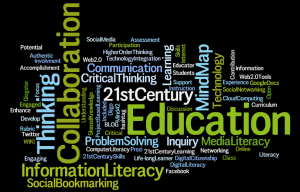Student Comments: Moving from Participation to Contribution by Maryellen Wiemer,PhD from Faculty Focus, identifies an interesting distinction between a student’s contribution to class discussion and simple participation. Originally quoted by Gioia, “Participation connotes involvement, sharing and simply taking part. . .” Contribution implies “…intellectual involvement and sharing of knowledge and knowledge construction. Concentrating on contribution causes people to think about what they are going to say, instead of simply blurting out ill-considered opinions, superficial observation, and irrelevant personal examples. ” (p. 16) Teachers have struggled with this classroom dilemma for decades. Many strategies have been suggested (and employed) in an effort to steer the learning experience toward the best possible outcome; to encourage contribution as opposed to superficial participation.
One could make a strong argument for the use of web2.0 tools and an online discussion model as a means to accomplish these preferred, higher-quality contributions as outlined by Wiemer and Gioia. The article describes what students typically accomplish when making a contribution to any discussion. These include providing summaries; making observations; integrating concepts; and asking questions that lead to further discussion. New technology tools such as blogs, wikis, wallwisher, Diigo and others, also achieve this same interactive and collaborative result. Online discussions naturally allow for Gioia’s “think breaks” where participants can take the time necessary to reflect and add worthwhile, thoughtful comments. Successful online environments are not only nurturing collaboration but also accomplishing valuable contributions with a much larger, authentic audience and engaging students through natural inquiry and creativity. Online “we are hearing contributions that promote understanding, develop knowledge, and result in discussions where student voices dominate”.
Reference: “Student Comments: Moving from Participation to Contribution | Faculty Focus.” Faculty Focus Student Comments Moving from Participation to Contribution Comments. N.p., n.d. Web. 15 Feb. 2013.
 As with most things, I have always approached online courses with expected anticipation, some necessary determination and to some small degree -trepidation. But I have to say that I have so enjoyed our work together that, as our class comes to a close, I find myself …well…wanting more. So the first thing I’d like to do is say Thank You to all my classmates and of course Neil for your encouragement , support and contributions toward a great leaning experience . I think what amazed me most was our group chemistry – if you will. If we could just bottle it up and apply it to our own classrooms, we’d be turning out life-long learners in not time! It’s been a real pleasure to have been a part of such a positive collaborative effort!
As with most things, I have always approached online courses with expected anticipation, some necessary determination and to some small degree -trepidation. But I have to say that I have so enjoyed our work together that, as our class comes to a close, I find myself …well…wanting more. So the first thing I’d like to do is say Thank You to all my classmates and of course Neil for your encouragement , support and contributions toward a great leaning experience . I think what amazed me most was our group chemistry – if you will. If we could just bottle it up and apply it to our own classrooms, we’d be turning out life-long learners in not time! It’s been a real pleasure to have been a part of such a positive collaborative effort!
